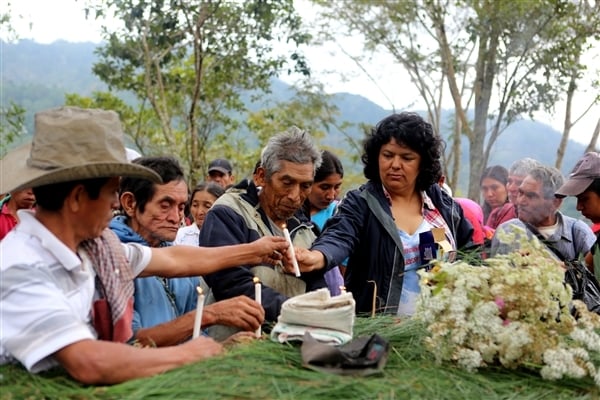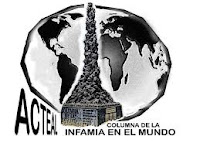
Author
Sobre el tema: La Tormenta y el Día Después. Novena parte: Primeros Auxilios para el Día Después | Los Tercios Compas y ͶÀTIꟼAƆ ⅃Ǝ
Sobre el tema: La Tormenta y el Día Después.
Novena parte: Primeros Auxilios para el Día Después
El Sistema de Salud Autónoma Zapatista dirigió una carta-protesta a la Capitanía de Puerto manifestando su inconformidad frente al tratamiento de la picadura de la araña violinista, referida en la octava parte: “otro día después”.
Primero desconocen la existencia del cargo de “Jefe Supremo de la Prevención de Salud, Vacunación, Lava tu mano, Necropsias y Anexas, Certificados de Defunción y demás”, que no existe en el organigrama de los servicios de salud zapatista. Tampoco hay inscrito ningún escarabajo en formadores y promotores de salud autónoma. Dicho lo anterior, señalan que no es de fiar la anécdota referida por el capitán (yo mero) del ataque sufrido por una araña musical. Pero, dando por descontado que el capitán tiene muy revuelto su pensamiento en su cabeza -y frente a lo cual recomiendan una operación invasiva de su cerebro (oh, oh, se ofrecen a practicarla)-, insisten en que se están preparando para el día después.
Para tranquilidad de quienes padecen las enfermedades del arte y la ciencia (así dice la carta), les aseguran que actualmente se están dando cursos de primeros auxilios en todas las comunidades zapatistas.
Detallan que podrán dar atención inicial para piquetes de araña, alacrán y víbora; heridas por corte de machete, caída de caballo, de vehículo motorizado y de árbol; atragantamiento y ahogamiento en ríos, lagunas, charcos y en vasos de agua. Presumen que, con sus poderosas bicicletas mecánicas y eléctricas, podrán llegar más rápido al lugar de la desgracia y administrar los primeros auxilios, mientras llega un vehículo para transportar a la víctima a la clínica más cercana. De ahí, según el caso, o cosa, se moverían al futuro laboratorio y al deseable quirófano -donde esperad@s cirujan@s y laboratoristas darán cursos, experimentarán con los fluidos y órganos de los pacientes, y meterán cuchillo con singular alegría-.
Sin embargo, declaran que, frente a una araña, la recomendación de “corre por tu vida”, es acertada. Para dejar de fumar, insisten con ingenuidad, no hay que esperar al día después: hay que hacerlo ya. Já.
Para enfatizar lo dicho, mandan unos videos de fragmentos de los cursos.
Es todo.
Desde la lista de espera para ser intervenido con una lobotomía.

El Capitán, fumando su enésima pipa y prometiendo que, mañana sí, dejará el vicio.
Noviembre del 2024.
P.D.- Sí me picó una araña violinista. Pero el instrumento musical no aparece y los promotores no ofrecen apoyo para su búsqueda.
OTRA P.D.- Llegaron la Verónica y el Chuy con sus motosierras (cfr. “Comando Palomitas”). Que para operarme, dijeron. Les disuadí con paletas de chamoy, pero temo que regresen. Ya nada está seguro, oiga.
Videos de Los Tercios Compas y música «Feeling Good» de Nina Simone
Sobre el tema: La Tormenta y el Día Después. Octava Parte: Otro día después | ͶÀTIꟼAƆ ⅃Ǝ
Sobre el tema: La Tormenta y el Día Después.
Octava Parte: Otro día después.
¡Uf! Usted ya la ha librado en la parte de las presentaciones.
Ahora está preparándose para ir al trabajo que le han encomendado. Debe de ir a la hortaliza/ la milpa / el taller mecánico / el depósito de tablas / la cocina / el comedor / el auditorio en ciernes / la escuela comunitaria / etcétera / etcétera / ¿ya dije que etcétera?
Se prepara mentalmente, aspira y expira (aunque más parece que suspira). Está por preguntar dónde diablos queda el lugar, cuando una jovencita (usted calcula que debe andar entre los 19 y 20 años), se le acerca y le saluda.
Sonriendo se presenta: “Yo me llamo Defensa y me “apedillo” “Zapatista”, ¿tú cómo te llamas?” Usted titubea antes de dar su nombre, y lamenta no haber podido elegir su nombre con algo así de sugerente.
Ella sigue sonriendo y dice: “Yo te voy a acompañar a donde te toca. Voy a cuidar que no te pase nada malo”.
Usted se desconcierta: “¿Nada malo? ¿Como qué?”
La muchachita: “Pues de repente hay garrapata, mostacilla, culebra, alacrán o araña. El otro día al capitán le picó una araña que le dicen “violinista”. Violinista la araña, no el capitán. Ése no toca ni la puerta”.
Usted traga saliva. La muchacha, tomándole de la mano y encaminándole al lugar: “yo te voy a enseñar lo que te toca y te voy a cuidar”. Sigue: “sabemos que vales y te tenemos que cuidar. En la comunidad, desde antes de que pasara todo lo que pasó, ya sabíamos y entendíamos que gente como tú es importante para mañana”.
Usted siente que el corazón se le hace como garapiñado y le entra una basurita en el ojo, pero trata de mantenerse ecuánime. Como suele decir su guardiana: “Nada de que nada, resistencia y rebeldía”.
Mientras caminan por una brecha, un ruido de pájaros agitados se escucha. Claro, usted piensa que es una jauría de culebras, alacranes y arañas. Queda inmóvil. La jovencita ríe y le explica:
“Es el pájaro que llamamos “Juanchío”, porque hace así cuando canta: “juanchío, juanchío”. Eso quiere decir que está contento su corazón. Míralo, es negro. A ese pájaro lo queremos y cuidamos, porque casi siempre anda en colectivo. Con varios pues. Y cuando ve un peligro, avisa. Hace “pit, pit, pit”. Pero como son varios, hacen una gran bulla. Y cada vez más fuerte y se juntan más, y te señalan con su bulla dónde mero está la amenaza, depende si es culebra o gato de monte. O sea que te señala dónde mero está el mal”
Usted traga saliva de nuevo y pregunta “¿También hay gato de monte?”.
“Sí”, responde ella, “creo que ustedes le dicen “tigrillo”. Es más pequeño que el puma.”
“¡¿P… p.. puma?!, usted tartamudea y, para sus adentros, maldice al sistema, la tormenta y el día después.
Sigue ella: “También les avisa a los animalitos más pequeños cuando anda rondando el gavilán o el águila o la culebra. En colectivo se turnan para picotear al malo, para que les dé tiempo a los pequeños de protegerse”.
Usted tiene la piel ya color blanco deslavado cuando pregunta: “Y ahorita, ¿es culebra o gato de monte o puma?”.
“Ninguno”, dice ella riendo. “Sólo es amor. Se están enamorando dos, el macho y la hembra, y hacen mucha bulla y hasta quedan como flotando en el aire para que se vean que están muy galanes”.
Usted debe estar temblando todavía, porque la jovencita le aclara: “Pero no te preocupes, también se pelean y se regañan. Se quieren pues”.
-*-
Más tarde, en el comedor, instintivamente se sientan juntos quienes tenían como maldición, y ahora como bendición, las artes y las ciencias. Cada quien empieza a contar cómo le fue en su primer día como parte del todo que acá llaman “comunidad”.
Cuando es su turno y usted inicia con el nombre de su guardiana, alguien más recuerda que la suya se llama “Esperanza Zapatista”. Y agrega: “y la esperanza, en estos tiempos, siempre se agradece”.
Alguien de ciencias aplicadas les interrumpe: “Tuvieron suerte. Mi guardiana se presentó con el nada tranquilizador nombre de “la Calamidad Zapatista”. No sé, pero no me siento con tranquilidad. Presiento que algo malo puede pasar”.
Las carcajadas resuenan en el maltrecho galerón que sirve de comedor y que, a la entrada y para nombrarlo, tiene un letrero que decreta: “Al menos en la comida, ¡ni un paso atrás! (si toca bañar, mejor piénsalo bien)”.
-*-
P.D. QUE INTERRUMPE Y DONDE EL CAPITÁN ACLARA QUE SÍ PERO NO (el misterioso caso del violín extraviado). – Sí, me picó una araña de las llamadas “violinista”. Hice lo que cualquier varón hetero, culto, y bien informado haría. Es decir, tomé una de esas cajitas de toques eléctricos (que antes había en parques, ferias de pueblo, kermeses y cantinas -y que no sé si todavía existen-), y me automediqué una descarga al tope. 120 voltios que superan cualquier café negro cargado.
Esperé pacientemente pero no. Mi legendaria torpeza, curtida en décadas de práctica consciente, seguía. Probé a ver si podía escalar por las paredes, pero los perritos sólo me miraban y, pensando que era un baile de moda para el TikTok, trataban de imitar los movimientos. Resumen: no me transformé. Tendré que seguir siendo un superhéroe sin superpoderes. Eso sí, la araña murió envenenada. ¿Eh? ¿Creen que debo preocuparme? Yo creo que faltó voltaje… Moraleja: no le crean a Peter Parker. Si ven una araña, no entren en pánico. Sólo corran por su vida.
-*-
Al poco tiempo, llegó el que se presentó como “Jefe Supremo de la Prevención de Salud, Vacunación, Lava tu mano, Necropsias y Anexas, Certificados de Defunción y demás”. ¿Es necesario aclararles que el sujeto se parecía extraordinariamente a un escarabajo?
Entró a la champa, cubrió el cuarto con una rápida mirada y dijo: “Vengo a ver a la víctima”. Aunque desconfiado por el aspecto del “jefe etcétera”, me arremangué la camisa y esperé que pusiera el baumanómetro. El: “Usted no. Dije la víctima, o sea la araña”. Extrañado le señalé el rincón donde yacía el cadáver de la ahora mártir. Se acercó el escarabajo con bata médica y la analizó con detalle. Cuando estuvo satisfecho, declaró: “No hay duda, murió por una sobre dosis de nicotina”. Luego, inquisidor, agregó: “¿Fuma usted mucho?”. Yo: “a veces, poco, muy de vez en cuando, aunque siempre sí un poco bastante”. “Ajá”, dijo el médico forense. “Me temo mi narizón amigo que usted tiene delito. Dos delitos, para ser más preciso”. “¿Yo? ¿Por qué? Ella empezó primero porque me picó sin avisar siquiera”. El sujeto sacó una libretita a saber de dónde y, escribiendo en ella, agregó: “Homicidio por transfusión en grado perverso. Uh, eso es grave, está usted en problemas.” Yo traté de protestar: “Pero Durito…” Él: “Nada de Durito, debe usted dirigirse a mí como “su Eminencia” y el otro delito es… mh… mh… ¡robo de instrumento artístico!” Yo estaba desconcertado: “¡Pero no robé nada!”. El fiscal artrópodo: “¿No es esa una araña violinista?” “Sí´, así les dicen”, titubee. “Ergo, ¿dónde está el violín?”
-*-
He buscado el violín por todas partes y nada. Estaba pensando que tal vez necesitaría un abogado, cuando apareció el mismo personaje, pero ahora con toga y birrete. Entra con paso ceremonioso y me extiende una tarjeta en la que se lee “Despacho Jurídico Duro pero Tupido”, presidente, principal accionista y único miembro: Don Durito, fiscal, juez, abogado y verdugo de las causas perdidas. Tenemos servicio a domicilio con aplicación digital -el servicio Premium incluye descuentos en la estadía en “El infierno de todos tan temido”-. Tarifas módicas. Sólo euros, dólares canadienses y yuanes.”
Creo que estoy perdido… ¡Manden tabaco, razaaaa! Haiga cosa, oiga.
Moraleja 2. – No fumen. Además de poner en peligro su salud, arriesgan su libertad.
Desde el techo de la champa, preparando mi mejor salto al vacío.

El Capitán.
Noviembre del 2024.
Fuente: Enlace Zapatista






